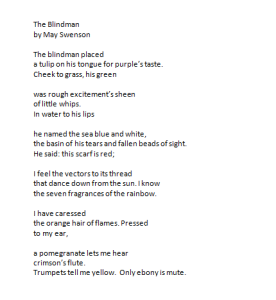As a lover of words and their many meanings, I spend much time surrounded by books–especially books of poetry. I like to randomly select a book off of a shelf and bring it home with me, so that I can expose myself to more poetic forms or poets I would’ve otherwise not found my way to for a while. I did this the other day, and I selected “Half Sun Half Sleep” by May Swenson. On flipping through the pages, I was drawn to one poem in particular, and I will go forth in taking it apart for the rest of this post.
I think what originally drew me to this poem, aside from my enjoyment at spontaneity, was the shorter stanzas and lines. The poem is arranged as a series of tersets, the middle line tending to me the longest out of the others. There is an irregular meter which compliments the ruggedness of not being able to use freely all five senses as a human being. With each line, the line breaks created by Swenson gracefully facilitates the rhyming pattern that persists at the end of each sentence.
Each stanza brings a new layer to the poem, concerned with this blindman and the ways he tries to experience color without eyesight. However, just as the blindman is experiencing new sensory ways to experience color, the sighted person is left wondering what not seeing color is like– culminating in the end with “only ebony is mute”–an image which brings up darkness or emptiness.
The use of color in this poem is especially intriguing to me–we are spoon fed cliches from our kindergarten glue-eating days that teach us to associate certain things with certain colors–grass is green, the sun is yellow-orange, fire is orange-red, etc. These seem like very simple things to know and understand; but this poem forces us to consider how a blind MAN must feel, only ever being told what color the world around him is and not ever being able to fully experience it for himself. This is emphasized in the poem by the line breaks between each stanza’s first and second lines– the first line introduces a new method of sensing stimuli besides seeing, and the second line introduces us to the color that the blindman is trying to get closer to: “I have caressed/the orange hair of flames. Pressed” this obviously alludes to our sense of touch, and the flames of a fire. Further, Swenson’s line break after “Pressed” emphasizes the hardened actions of not just touching but ‘caressing’ a flame; capturing the vulnerability which must be felt by this person who is blind but so desperately wants to experience something as universal and integral to the world around us as color.
One of my favorite moments in this poem is the raw and visceral image of the blindman’s tears as “fallen beads of sight”- “In water to his lips/he named the sea blue and white/the basin of his tears and fallen beads of sight” (31). May Swenson does a great job of instilling a sense of empathy in the reader, capturing this man’s emotional difficulty but desperation, as well as exploring the abstract nature of color.

